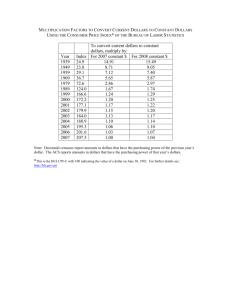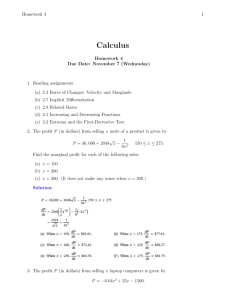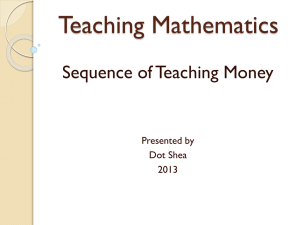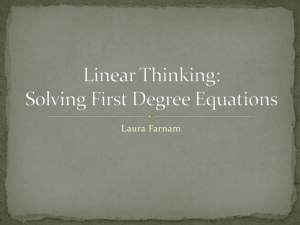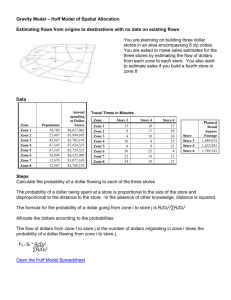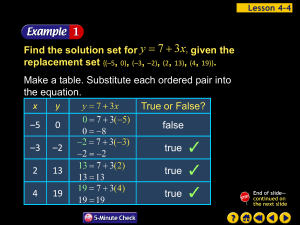CHAPTER 7 SUGGESTED ANSWERS TO CHAPTER 7 QUESTIONS
advertisement
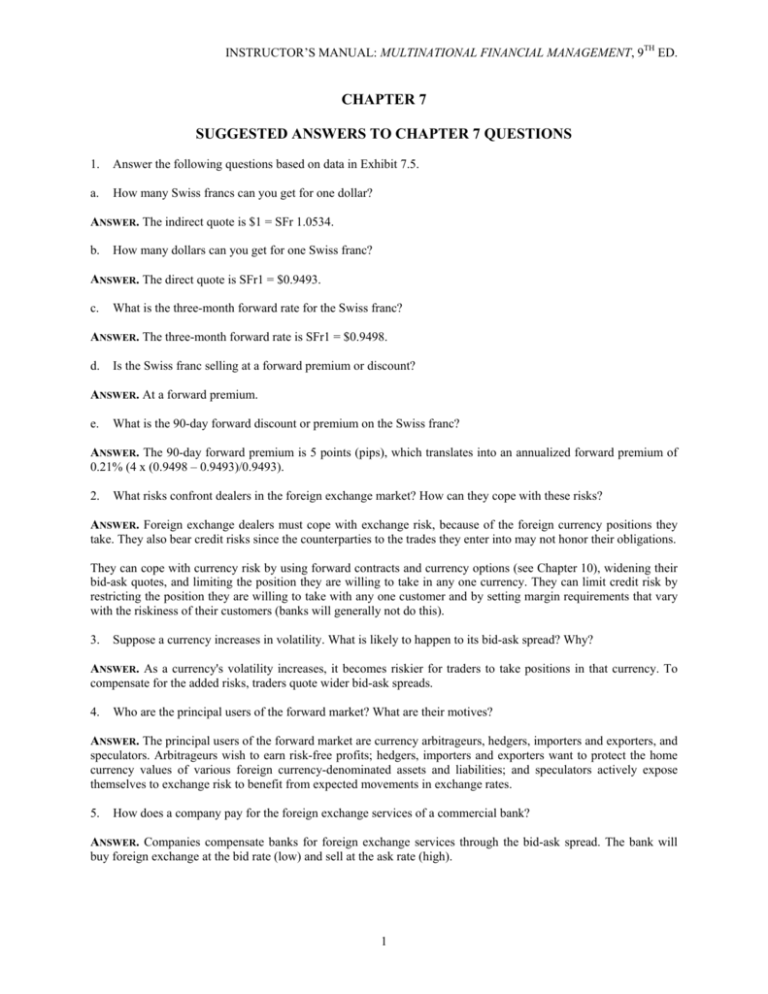
INSTRUCTOR’S MANUAL: MULTINATIONAL FINANCIAL MANAGEMENT, 9TH ED. CHAPTER 7 SUGGESTED ANSWERS TO CHAPTER 7 QUESTIONS 1. Answer the following questions based on data in Exhibit 7.5. a. How many Swiss francs can you get for one dollar? ANSWER. The indirect quote is $1 = SFr 1.0534. b. How many dollars can you get for one Swiss franc? ANSWER. The direct quote is SFr1 = $0.9493. c. What is the three-month forward rate for the Swiss franc? ANSWER. The three-month forward rate is SFr1 = $0.9498. d. Is the Swiss franc selling at a forward premium or discount? ANSWER. At a forward premium. e. What is the 90-day forward discount or premium on the Swiss franc? ANSWER. The 90-day forward premium is 5 points (pips), which translates into an annualized forward premium of 0.21% (4 x (0.9498 – 0.9493)/0.9493). 2. What risks confront dealers in the foreign exchange market? How can they cope with these risks? ANSWER. Foreign exchange dealers must cope with exchange risk, because of the foreign currency positions they take. They also bear credit risks since the counterparties to the trades they enter into may not honor their obligations. They can cope with currency risk by using forward contracts and currency options (see Chapter 10), widening their bid-ask quotes, and limiting the position they are willing to take in any one currency. They can limit credit risk by restricting the position they are willing to take with any one customer and by setting margin requirements that vary with the riskiness of their customers (banks will generally not do this). 3. Suppose a currency increases in volatility. What is likely to happen to its bid-ask spread? Why? ANSWER. As a currency's volatility increases, it becomes riskier for traders to take positions in that currency. To compensate for the added risks, traders quote wider bid-ask spreads. 4. Who are the principal users of the forward market? What are their motives? ANSWER. The principal users of the forward market are currency arbitrageurs, hedgers, importers and exporters, and speculators. Arbitrageurs wish to earn risk-free profits; hedgers, importers and exporters want to protect the home currency values of various foreign currency-denominated assets and liabilities; and speculators actively expose themselves to exchange risk to benefit from expected movements in exchange rates. 5. How does a company pay for the foreign exchange services of a commercial bank? ANSWER. Companies compensate banks for foreign exchange services through the bid-ask spread. The bank will buy foreign exchange at the bid rate (low) and sell at the ask rate (high). 1 CHAPTER 7: THE FOREIGN EXCHANGE MARKET ADDITIONAL CHAPTER 7 QUESTION AND ANSWER 1. How have forward premiums and discounts relative to the dollar changed over annual intervals during the past five years for the Japanese yen, British pound, euro, Swiss franc, and Canadian dollar? Use beginning of year data. ANSWER. This question can only be answered by reference to the data. SUGGESTED SOLUTIONS TO CHAPTER 7 PROBLEMS 1. The $: € exchange rate is €1 = $1.45, and the €/SFr exchange rate is SFr 1 = €0.71. What is the SFr/$ exchange rate? ANSWER. SFr1 = €0.71 x 1.45 = $1.0295. 2. Suppose the direct quote for sterling in New York is 1.9110-5. What is the direct quote for dollars in London? ANSWER. The direct quote for the dollar in London is just the reciprocal of the direct quote for the pound in New York or 1/1.9115 - 1/1.9110 = 0.5231-3. 3. Using the data in Exhibit 7.5, calculate the 30-day, 90-day, and 180-day forward discounts for the Canadian dollar. ANSWER. Here are the relevant rates for the Canadian dollar: Spot: C$1 = $1.0078 30-day forward: C$1 = $1.0073 90-day forward: C$1 = $1.0069 180-day forward: C$1 = $1.0066 The 30-day forward discount is: [($1.0073 - $1.0078)/$1.0078] x 12 = -0.60% The 90-day forward discount is: [($1.0069 - $1.0078)/$1.0078] x 4 = -0.36% The 180-day forward discount is: [($1.0066 - $1.0078)/$1.0078] x 2 = -0.24% In this case, the forward discounts at these maturities are relatively small, indicating that Canadian and U.S. interest rates are close to each other. 4. An investor wishes to buy euros spot (at $1.3908) and sell euros forward for 180 days (at $1.3996). a. What is the swap rate on euros? ANSWER. A premium of 88 points. b. What is the premium on 180-day euros? ANSWER. The 180-day premium is (1.3996 - 1.3908)/1.3908 x 2 = 1.27%. 5. Suppose Credit Suisse quotes spot and 90-day forward rates on the Swiss franc of $0.7957-60, 8-13. a. What are the outright 90-day forward rates that Credit Suisse is quoting? ANSWER. The outright forwards are: bid rate = $0.7965 (0.7957 + 0.0008) and ask rate = $0.7973 (0.7960 + 0.0013). 2 INSTRUCTOR’S MANUAL: MULTINATIONAL FINANCIAL MANAGEMENT, 9TH ED. b. What is the forward discount or premium associated with buying 90-day Swiss francs? ANSWER. The annualized forward premium = [(0.7973 - 0.7960)/0.7960]x 4 = 0.65%. c. Compute the percentage bid-ask spreads on spot and forward Swiss francs. ANSWER. The bid-ask spread is calculated as follows: Percent spread = Ask price - Bid price x 100 Ask price Substituting in the numbers yields a spot bid-ask spread of (0.7960 - 0.7957)/0.7960 = 0.04%. The corresponding forward bid-ask spread is (0.7973 - 0.7965)/0.7973 = 0.10%. 6. Suppose Dow Chemical receives quotes of $0.009369-71 for the yen and $0.03675-6 for the Taiwan dollar (NT$). a. How many U.S. dollars will Dow Chemical receive from the sale of ¥50 million? ANSWER. Dow must sell yen at the bid rate, meaning it will receive from this sale $468,450 (50,000,000 x 0.009369). b. What is the U.S. dollar cost to Dow Chemical of buying ¥1 billion? ANSWER. Dow must buy at the ask rate, meaning it will cost Dow $9,371,000 (1,000,000,000 x 0.009371) to buy ¥1 billion. c. How many NT$ will Dow Chemical receive for U.S. $500,000? ANSWER. Dow must sell at the bid rate for U.S. dollars (which is the reciprocal of the ask rate for NT$, or 1/0.03676), meaning it will receive from this sale of U.S. dollars NT$13,601,741 (500,000/0.03676). d. How many yen will Dow Chemical receive for NT$200 million? ANSWER. To buy yen, Dow must first sell the NT$200 million for U.S. dollars at the bid rate and then use these dollars to buy yen at the ask rate. The net result from these transactions is ¥784,334,649.45 (200,000,000 x 0.03675/0.009371). e. What is the yen cost to Dow Chemical of buying NT$80 million? ANSWER. Dow must sell the yen for dollars at the bid rate and then buy NT$ at the ask rate with the U.S. dollars. The net yen cost to Dow from carrying out these transactions is ¥313,886,220.51 (80,000,000 x 0.03676/0.009369) 7. Suppose the euro is quoted at 0.6064-80 in London, and the pound sterling is quoted at 1.6244-59 in Frankfurt. a. Is there a profitable arbitrage situation? Describe it. ANSWER. Sell pounds for €1.6447/£ (1/0.6080) in London. Use the Euros to buy pounds for €1.6259/£ in Frankfurt. There is a net profit of €0.0188 per pound bought and sold–a percentage yield of 1.15% (0.0188/1.6447). b. Compute the percentage bid-ask spreads on the pound and euro. ANSWER. The percentage bid-ask spreads on the pound and euro are calculated as follows: 3 CHAPTER 7: THE FOREIGN EXCHANGE MARKET £ bid-ask spread = (1.6259 - 1.6244)/1.6259 = 0.09% Euro bid-ask spread = (0.6080 - 0.6064)/0.6080 = 0.26% 8. As a foreign exchange trader at Sumitomo Bank, one of your customers would like a yen quote on Australian dollars. Current market rates are: Spot ¥101.37-85/U.S.$1 A$1.2924-44/U.S.$1 a. 30-day 15-13 20-26 What bid and ask yen cross rates would you quote on spot Australian dollars? ANSWER. By means of triangular arbitrage, we can calculate the market quotes for the Australian dollar in terms of yen as ¥78.31-81/A$1 These prices can be found as follows. For the yen bid price for the Australian dollar, we need to first sell Australian dollars for U.S. dollars and then sell the U.S. dollars for yen. It costs a$1.2944 to buy U.S. $1. With U.S. $1 we can buy ¥101.37. Hence, A$1.2944 = ¥101.37, or A$1 = ¥78.31. This is the yen bid price for the Australian dollar. The yen ask price for the Australian dollar can be found by first selling yen for U.S. dollars and then using the U.S. dollars to buy Australian dollars. Given the quotes above, it costs ¥101.85 to buy U.S. $1, which can be sold for a$1.2924. Hence, A$1.2924 = ¥101.85, or A$1 = ¥78.81. This is the yen ask price for the Australian dollar. As a foreign exchange trader, you would try to buy Australian dollars at slightly less than ¥78.31 and sell them at slightly more than ¥78.81. Buying and selling Australian dollars at the market price will leave you with no profit. How much better than the market prices you can do depends on the degree of competition you face from other traders and the extent to which your customers are willing to shop around to get better quotes. b. What outright yen cross rates would you quote on 30-day forward Australian dollars? ANSWER. Given the swap rates, we can compute the outright forward direct quotes for the yen and Australian dollar by adding or subtracting the forward points as follows Spot ¥101.37-85/U.S.$1 A$1.2924-44/U.S.$1 30-day 15-13 20-26 30-day outright forward rates ¥101.22-72/U.S.$1 A$1.2944-70/U.S.$1 By means of triangular arbitrage, we can then calculate the market quotes for the 30-day forward Australian dollar in terms of yen as ¥78.04-58/A$1 These prices can be found as follows. For the yen bid price for the forward Australian dollar, we need to first sell Australian dollars forward for U.S. dollars and then sell the U.S. dollars forward for yen. It costs a$1.2970 to buy U.S. $1 forward. With U.S. $1 we can buy ¥101.22. Hence, A$1.2970 = ¥101.22, or A$1 = ¥78.04. This is the yen bid price for the forward Australian dollar. The yen ask price for the Australian dollar can be found by first selling yen forward for U.S. dollars and then using the U.S. dollars to buy forward Australian dollars. Given the quotes above, it costs ¥101.72 to buy U.S. $1, which can be sold for a$1.2944. Hence, A$1.2944 = ¥101.71, or A$1 = ¥78.58. This is the yen ask price for the forward Australian dollar. 4 INSTRUCTOR’S MANUAL: MULTINATIONAL FINANCIAL MANAGEMENT, 9TH ED. c. What is the forward premium or discount on buying 30-day Australian dollars against yen delivery? ANSWER. As shown in parts a and b, the ask rate for 30-day forward Australian dollars is ¥78.58 and the spot ask rate is ¥78.81. Thus, the Australian dollar is selling at a forward discount to the yen. The annualized discount equals -3.43%, computed as follows: Forward premium Forward rate Spot rate 360 78.58 - 78.81 360 = x = x = - 3.43% Forward contract or discount Spot rate 78.81 30 number of days 9. Suppose Air France receives the following indirect quotes in New York: €0.92 - 3 and £0.63 - 4. Given these quotes, what range of £/ € bid and ask quotes in Paris will permit arbitrage? ANSWER. Triangular arbitrage can take place in either of two ways: (1) Convert from euros to dollars (at the ask rate), then from dollars to pounds (at the bid rate), or (2) convert from pounds to dollars (at the ask rate), then from dollars to euros (at the bid rate). The first quote will give us the bid price for the euro in terms of the pound and the second quote will yield the ask price. Using the given rates, Air France would end up with the following amounts: (1) Euros to pounds = = = €/$ (ask) x 0.93 x € 1.4762/£ or £0.6774/ € $/£ (bid) 1/0.63 (2) Pounds to euros = £/$ (ask) x 0.64 x £0.6957/€ or €1.4375/£ $/ € (bid) 1/0.92 = The import of the figures in method (1) is that Air France can buy pounds in New York for €1.4762/£, which is the equivalent of selling euros at a rate of £0.6774/ €. So, if Air France can buy euros in Paris for less than £0.6774/ € (which is the equivalent of selling pounds for more than €0.6774/£), it can earn an arbitrage profit. Similarly, the figures in method (2) tell us that Air France can buy euros in New York at a cost of £0.6957/ €. Given this exchange rate, Air France can earn an arbitrage profit if it can sell these euros for more than £0.6957/FF in Paris. Thus, Air France can profitably arbitrage between New York and Paris if the bid rate for the euro in Paris is greater than £0.6957/ € or the ask rate is less than £0.6774/ €. 10. On checking the Telerate screen, you see the following exchange rate and interest rate quotes: Currency 90-day interest rates annualized Dollar 4.99% - 5.03% Swiss franc 3.14% - 3.19% a. Spot rates 90-day forward rates $0.711 - 22 $0.726 - 32 Can you find an arbitrage opportunity? ANSWER. Yes. There are two possibilities: Borrow dollars and lend in Swiss francs or borrow Swiss francs and lend in dollars. The profitable arbitrage opportunity lies in the former: Lend Swiss francs financed by borrowing U.S. dollars. b. What steps must you take to capitalize on it? 5 CHAPTER 7: THE FOREIGN EXCHANGE MARKET ANSWER. Borrow dollars at 1.2575% for 90 days (5.03%/4), convert these dollars into francs at the ask rate of $0.722, lend the francs at 0.785% for 90 days (3.14%/4), and immediately sell the francs forward for dollars at the buy rate of $0.726. c. What is the profit per $1,000,000 arbitraged? ANSWER. The profit is $1,000,000 x [(1.00785/0.722) x 0.726 - 1.012575] = $858.66. ADDITIONAL CHAPTER 7 PROBLEMS AND SOLUTIONS 1. Suppose the quote on pounds is $1.624-31. a. If you converted $10,000 to pounds and then back to dollars, how many dollars would you end up with? ANSWER. For $10,000, you would buy pounds at the price of $1.631, giving you £6,131.21 ($10,000/1.631) and resell them at the bid price of $1.624. The latter transaction would yield $9,957.08, resulting in a round-trip cost of $42.92. b. Suppose you could buy pounds at the bid rate and sell them at the ask rate. How many dollars would you have to transact in order to earn $1,000 on a round-trip transaction (buying pounds for dollars and then selling the pounds for dollars)? ANSWER. For every pound you could buy at the bid and sell at the ask, you would earn the spread of $0.007. To earn $1,000, you would have to transact £142,857.14 ($1,000/$0.0007). At the current bid rate of $1.624, this is equivalent to $232,000 (142,857.14 x $1.624). 2. Using the following data, calculate the 30-day, 90-day, and 180-day forward premiums for the British pound. Spot: 30-day forward: 90-day forward: 180-day forward: £1 = $1.4487 £1 = $1.4498 £1 = $1.4511 £1 = $1.4529 ANSWER. Here are the relevant calculations for the pound: The 30-day forward premium is: [($1.4498 - $1.4487)/$1.4487] x 12 = 0.91% The 90-day forward premium is: [($1.4511 - $1.4487)/$1.4487] x 4 = 0.66% The 180-day forward premium is: [($1.4529 - $1.4487)/$1.4487] x 2 = 0.58% The small forward premiums at these maturities indicate that British and U.S. interest rates are very close. 3. The spot and 90-day forward rates for the pound are $1.1376 and $1.1350, respectively. What is the forward premium or discount on the pound? ANSWER. The forward premium (discount) on the British pound is [(f1 - e0)/e0] x (360/n) = [(1.1350 - 1.1376)/1.1376] x 4 = -.91% which is a forward discount of .91%. 4. Suppose the spot quote on the euro is $0.9302-18, and the spot quote on the Swiss franc is $0.6180-90. a. Compute the percentage bid-ask spreads on the euro and franc. 6 INSTRUCTOR’S MANUAL: MULTINATIONAL FINANCIAL MANAGEMENT, 9TH ED. ANSWER. The percentage bid-ask spreads on the euro and franc are calculated as follows: Euro bid-ask spread = (0.9318 - 0.9302)/0.9318 = 0.17% SFr bid-ask spread = (0.6190 - 0.6180)/0.6190 = 0.16% b. What is the direct spot quote for the franc in Frankfurt? ANSWER. In order to sell one franc for euros, first sell the franc for $0.6180 and then convert $0.6180 into euros at the ask rate of $0.9318. Thus the bid rate for the franc is 0.6180/0.9318 = €0.6632. Similarly, to acquire one franc, sell euros for dollars and then sell dollars for francs. Specifically, it costs $0.6190 to buy €1. Because €1 can be converted into $0.9302, it takes €0.6190/0.9302 = €0.6654 to buy $0.6190. Thus the ask rate for francs is €0.6654. The bid-ask quote on the franc in Frankfurt is therefore €0.6632-54. 5. Suppose you observe the following direct spot quotations in New York and Toronto, respectively: 0.8000-50 and 1.2500-60. What are the arbitrage profits per $1 million? ANSWER. Converting the direct quotes in Toronto into indirect quotes yields bid-ask rates for the Canadian dollar in terms of the U.S. dollar of U.S.$.7962-.8000. Hence, there is no arbitrage opportunity. 6. Assuming no transaction costs, suppose £1 = $2.4110 in New York, $1 = FF 3.997 in Paris, and FF 1 = £0.1088 in London. How could you take profitable advantage of these rates? ANSWER. Sell pounds in New York for $2.4110 apiece. Sell the dollars in Paris for FF 3.997, and sell the francs in London for £.1088. This sequence of transactions yields 2.4110 x 3.997 x .1088 pounds or £1.0485 per pound initially traded. 7. Suppose the euro is quoted at $0.8782-92, while the yen is quoted at $0.001760-69. a. Given these quotes for the euro and yen, what is the maximum bid-ask spread in the ¥/DM rate for which there is no arbitrage? ANSWER. The ¥/ € bid rate based on triangular arbitrage is ¥496.44/€1 (0.8782/0.001769). Similarly, the ¥/€ ask rate based on triangular arbitrage is ¥499.55/€1 (0.8792/0.001760). Hence, the bid-ask spread based on triangular arbitrage is ¥499.55 - ¥496.44 = ¥3.11. This spread is the maximum one would expect. Beyond this spread, it would be profitable to engage in triangular arbitrage. b. What is the maximum bid-ask spread in percentage terms? ANSWER. The maximum bid-ask spread in percentage terms equals the maximum spread divided by the bid price or 3.11/496.44 = 0.63%. Relative to the ask price, this percentage is 0.62% (/499.55). 8. Assume that back in 1995 the pound sterling is worth FF 9.80 in Paris and SFr 5.40 in Zurich. a. Show how British arbitrageurs can make profits given that the Swiss franc is worth two French francs. What would be the profit per pound transacted? ANSWER. Sell pounds in Zurich for SFr 5.40. Sell Swiss francs in Zurich for FF2. Then buy pounds in Paris for FF9.80. This yields (5.40 x 2)/9.8 = £1.102 or a profit of £.102 per pound transacted. b. What would be the eventual outcome on exchange rates in Paris and Zurich given these arbitrage activities? ANSWER. The Swiss franc price of the pound would decline in Zurich. The Swiss franc would depreciate relative to the French franc. The pound would appreciate relative to the French franc in Paris. 7 CHAPTER 7: THE FOREIGN EXCHANGE MARKET c. Rework Part a, assuming that transaction costs amount to 0.6% of the amount transacted. What would be the profit per pound transacted? ANSWER. Each transaction costs 0.6%. Thus, at each stage the arbitrageur receives 99.4% of what he previously received. Thus after the three transactions undertaken in part a, the arbitrageur receives 1.102 x (.994)3 = £1.0823 for a profit per pound sold equal to £.0823. d. Suppose the Swiss franc is quoted at FF 2 in Zurich. Given a transaction cost of 0.6% of the amount transacted, what are the minimum/maximum French franc prices for the Swiss franc that you would expect to see quoted in Paris? ANSWER. With a transaction cost of .6%, an arbitrageur will receive 99.4% of what she would receive absent these costs. To find the maximum and minimum French franc prices for the Swiss franc that would be quoted in Paris, it is sufficient to invoke the following no-arbitrage conditions: 1. Converting FF1 into Swiss francs in Zurich and then converting the Swiss francs back into French francs in Paris should yield no more than one FF1. 2. Converting SFr 1 into French francs in Zurich and then converting the French francs back into Swiss francs in Paris should yield no more than SFr1. If e is the direct quote for the Swiss franc in Paris, the first no-arbitrage condition says that 0.5 x 0.994 x e x 0.994 < 1 or e < 2.0242 According to the second no-arbitrage condition, 2 x 0.994 x (1/e) x 0.994 < 1 or e > 1.9761 Combining these two inequalities yields the minimum and maximum exchange rates or 1.9761 < e < 2.0242. 9. On checking the Reuters screen, you see the following exchange rate and interest rate quotes: Currency 90-day interest rates Spot rates 90-day forward rates Pound 7 7/16 - 5/16% ¥159.9696-9912/£ ¥145.5731-8692/£ Yen 2 3/8 - 1/4% a. Can you find an arbitrage opportunity? ANSWER. There are two alternatives: (1) Borrow yen at 2 3/8%/4, convert the yen into pounds at the spot ask rate of ¥159.9912/£, invest the pounds at 7 5/16%/4. and sell the expected proceeds forward for yen at the forward bid rate of ¥145.5731/£, or (2) borrow pounds at 7 7/16%/4, convert the pounds into yen at the spot bid rate of ¥159.9696/£, invest the yen at 2 1/4%/4, and sell the proceeds forward for pounds at the forward ask rate of ¥145.8692/£. The first alternative will yield a loss of -¥7.94 per ¥100 borrowed, indicating that this is not a profitable arbitrage opportunity: (100/159.9912) x (1.0183) x 145.5731 - 100 x 1.0059 = -7.94 Switching to alternative 2, the return per £100 borrowed is £8.42, indicating that this is a very profitable arbitrage opportunity: 100 x 159.9696 x 1.0056/145.8692 - 100 x 1.0186 = 8.42 8 INSTRUCTOR’S MANUAL: MULTINATIONAL FINANCIAL MANAGEMENT, 9TH ED. b. What steps must you take to capitalize on it? ANSWER. The steps to be taken have already been outlined in the answer to part a. c. What is the profit per £1,000,000 arbitraged? ANSWER. Based on the answer to part a, the profit is £84,200 (8.42 x 10,000). NOTES ON FOREIGN EXCHANGE QUOTES 1. Spot rate - rate at which foreign exchange can be bought or sold for immediate delivery. €1 = $0.9107 SFr1 = $0.6340 a) Actual rates are given in pairs: a bid (buy) rate and ask (sell) rate €1 = $0.9107-10 SFr1 = $0.6340-42 b) Cross rates: €1 = SFr 1.4364 (0.9107/0.6340) €1 = SFr 1.4360-9 (0.9107/0.6342 - 0.9110/0.6340) c) Measuring currency changes Year 2: €1 = $0.9107 or $1 = €1.0981 Year 1: €1 = $0.8163 or $1 = €1.2250 The euro is said to have appreciated against the dollar by (0.9107 - 0.8163)/0.8163 = 11.56%. Alternatively, the dollar is said to have depreciated against the euro by (1.0981 - 1.2250)/1.2250 = - 10.37%. Thursday, January 9, 1986: Cr$1 = $0.00009615 or $1 = Cr$10400 Thursday, January 31, 1985: Cr$1 = $0.0002899 or $1 = Cr$3449.50 The Brazilian cruzeiro has depreciated against the dollar by (.00009615 - .0002899)/.0002899 = - 66.83%. Alternatively, the dollar has appreciated against the cruzeiro by (10400 - 3449.5)/3449.5 = 201.49%. Note: The new Brazilian currency is now the real. This example dates back to a time when the Brazilian currency was running a very high rate of inflation and so was continually devaluing 2. Forward rate - rate at which foreign exchange can be bought or sold today for delivery at a fixed future date, typically in multiples of 30 days, e.g., 30, 60, 90, or 180 days. a) Forward quotations 9 CHAPTER 7: THE FOREIGN EXCHANGE MARKET 30 day forward rates €1 = $0.9120 SFr1 = $0.6338 b) Forward premium (+) or discount (-) (annualized) = [(forward rate - spot rate)/spot rate] x (360/n) where n is the number of days in the forward contract. Thus, the euro is selling at an annualized forward premium of 1.71% against the dollar: [(0.9120 - 0.9107)/0.9107] x 12 = 1.71%. The Swiss franc is selling at an annualized forward discount of 0.38% against the dollar: [(0.6338 - 0.6340)/0.1340] x 12 = - 0.38%. c) Swap rates Spot rates: €1 = $0.9107-10 SFr1 = $0.6340-42 30-day forward rates: €1 = $0.9120-25 SFr1 = $0.6338-41 Expressed as: €1 = $0.9107-10 13-15 SFr1 = $0.6340-42 2-1 d) Cross rates on a 30-day forward contract: €1 = SFr1.4383-97 (0.9120/0.6341 - 0.9125/0.6338) 10

